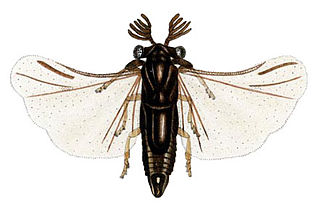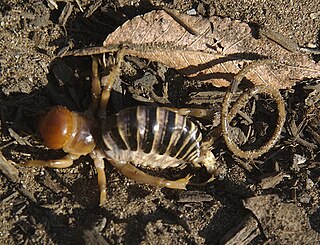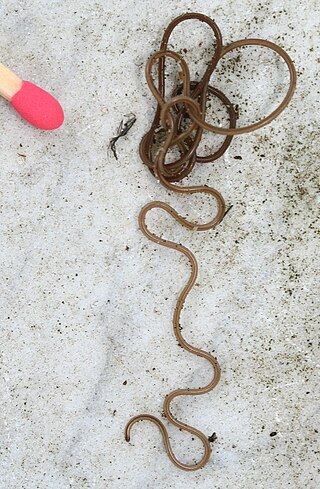
Nematomorpha are a phylum of parasitoid animals superficially similar to nematode worms in morphology, hence the name. Most species range in size from 50 to 100 millimetres, reaching 2 metres (79 in) in extreme cases, and 1 to 3 millimetres in diameter. Horsehair worms can be discovered in damp areas, such as watering troughs, swimming pools, streams, puddles, and cisterns. The adult worms are free-living, but the larvae are parasitic on arthropods, such as beetles, cockroaches, mantises, orthopterans, and crustaceans. About 351 freshwater species are known and a conservative estimate suggests that there may be about 2000 freshwater species worldwide. The name "Gordian" stems from the legendary Gordian knot. This relates to the fact that nematomorphs often coil themselves in tight balls that resemble knots.

The Strepsiptera are an order of insects with eleven extant families that include about 600 described species. They are endoparasites of other insects, such as bees, wasps, leafhoppers, silverfish, and cockroaches. Females of most species never emerge from the host after entering its body, finally dying inside it. The early-stage larvae do emerge because they must find an unoccupied living host, and the short-lived males must emerge to seek a receptive female in her host. They are believed to be most closely related to beetles, from which they diverged 300–350 million years ago, but do not appear in the fossil record until the mid-Cretaceous around 100 million years ago.

The Extended Phenotype is a 1982 book by the evolutionary biologist Richard Dawkins, in which the author introduced a biological concept of the same name. The book's main idea is that phenotype should not be limited to biological processes such as protein biosynthesis or tissue growth, but extended to include all effects that a gene has on its environment, inside or outside the body of the individual organism.

In evolutionary ecology, a parasitoid is an organism that lives in close association with its host at the host's expense, eventually resulting in the death of the host. Parasitoidism is one of six major evolutionary strategies within parasitism, distinguished by the fatal prognosis for the host, which makes the strategy close to predation.

Grasshoppers are a group of insects belonging to the suborder Caelifera. They are amongst what are possibly the most ancient living groups of chewing herbivorous insects, dating back to the early Triassic around 250 million years ago.

Necator americanus is a species of hookworm commonly known as the New World hookworm. Like other hookworms, it is a member of the phylum Nematoda. It is an obligatory parasitic nematode that lives in the small intestine of human hosts. Necatoriasis—a type of helminthiasis—is the term for the condition of being host to an infestation of a species of Necator. Since N. americanus and Ancylostoma duodenale are the two species of hookworms that most commonly infest humans, they are usually dealt with under the collective heading of "hookworm infection". They differ most obviously in geographical distribution, structure of mouthparts, and relative size.

Meconema thalassinum is an insect in the family Tettigoniidae known as the oak bush-cricket and drumming katydid. It is native to Europe, including the British Isles, and was introduced to the United States, first established in the west of Long Island and extending its range to Rhode Island and Scarsdale, Stony Brook, and Ithaca, New York.

Cotesia congregata is a parasitoid wasp of the genus Cotesia. The genus is particularly noted for its use of polydnaviruses. Parasitoids are distinct from true parasites in that a parasitoid will ultimately kill its host or otherwise sterilize it.

The nematodes, roundworms or eelworms constitute the phylum Nematoda. They are a diverse animal phylum inhabiting a broad range of environments. Most species are free-living, feeding on microorganisms, but many species are parasitic. The parasitic worms (helminths) are the cause of soil-transmitted helminthiases.

Crickets are orthopteran insects which are related to bush crickets, and, more distantly, to grasshoppers. In older literature, such as Imms, "crickets" were placed at the family level, but contemporary authorities including Otte now place them in the superfamily Grylloidea. The word has been used in combination to describe more distantly related taxa in the suborder Ensifera, such as king crickets and mole crickets.

Paragordius tricuspidatus belongs to the phylum Nematomorpha, and is known for manipulating the behavior of its host, the cricket Nemobius sylvestris. In its larval stage, the worm is microscopic, but grows into a large worm inside its host after accidental ingestion since their eggs are laid at the edge of the water by rivers where crickets frequently reside. Upon ingestion, the worm nourishes upon its host and fills the entire body cavity of the cricket, until maturation, when the parasitic worm is ready to exit into water to complete its life cycle, maximizing its reproductive success. The worm induces a peculiar behavior in its cricket host which causes the cricket to leap into water whereby the parasitic worm can slither out and find its mate, while the cricket often perishes. Should the cricket be preyed upon by a predator, such as a fish or frog, the worm has the ability to not only escape from the host's body but also the predator's digestive system. The worm emerges from the predator unharmed and proceeds to live its life normally.
Animal suicide is when an animal intentionally ends its own life through its actions. It implies a wide range of higher cognitive capacities that experts have been wary to ascribe to nonhuman animals such as a concept of self, death, and future intention. There is currently not enough empirical data on the subject for there to be a consensus among experts. For these reasons, the occurrence of animal suicide is controversial among academics.
Behavior-altering parasites are parasites capable of causing changes in the behavior of their hosts species to enhance their transmission, sometimes directly affecting the hosts' decision-making and behavior control mechanisms. By way of example, a parasite that reproduces in an intermediate host may require, as part of their life cycle, that the intermediate host be eaten by a predator at a higher trophic level, and some parasites are capable of altering the behavior of the intermediate host to make such predation more likely; a mechanism that has been called parasite increased trophic facilitation or parasite increased trophic transmission. Examples can be found in bacteria, protozoa, viruses, and animals. Parasites may also alter the host behavior to increase protection of the parasites or their offspring; the term bodyguard manipulation is used for such mechanisms.

Gordius is a genus of worms in the phylum Nematomorpha, the horsehair worms. It was formerly treated as the only genus in the family Gordiidae, but the genus Acutogordius is now considered as distinct. The genus is distributed worldwide except for Antarctica, where no Nematomorpha have been recorded.

Paragordius varius is a parasite species in the horsehair worm group (Nematomorpha). They cycle between terrestrial and aquatic habitats and are most commonly known for their ability to manipulate their definitive host to jump into a pool of water, which allows them to complete their life cycle. Adults are over 10 cm long and 400 μm in diameter. P. varius is usually found in water or wet areas. The definitive hosts are mainly terrestrial arthropods, most often carabid beetles, crickets and praying mantids.

Chordodes formosanus is a horsehair worm that has the praying mantis as its definitive host. Horsehair worms are obligate parasites that pass through different hosts at various stages. These worms can grow up to 90 centimetres (35 in) long and can be extremely dangerous for their host, especially the praying mantis.

Caedicia simplex is a species of bush cricket or katydid, native to New Zealand and Australia. A common name is the "common garden katydid".
Nectonema is a genus of marine horsehair worms first described by Addison E. Verrill in 1879. It is the only genus in the family Nectonematidae described by Henry B. Ward in 1892, in the order Nectonematoidea, and in the class Nectonematoida. The genus contains five species; all species have a parasitic larval stage inhabiting crustacean hosts and a free-living adult stage that swims in open water.

Gordiidae is a family of parasitic horsehair worms belonging to the order Gordioidea.

Paragordius is a genus of worms belonging to the family Chordodidae. It was independently described by both Lorenzo Camerano in 1897 and Thomas Harrison Montgomery Jr. in 1898, though both authors gave the genus the same name.















